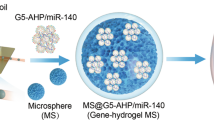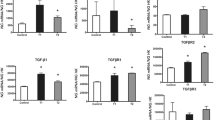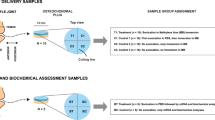Abstract
To determine the most efficient in vivo delivery method of oligonucleotides for antisense therapy in ligament healing, fluorescence-labelled phosphorothioate oligodeoxynuleotides (ODN) were introduced into 12 rabbit ligament scars 2 weeks after injury using haemagglutinating virus of Japan (Sendai virus; HVJ)-conjugated liposomes. We compared the efficiency of cellular uptake of fluorescence as a percentage of all cells in each scar using three delivery procedures: (1) direct free-hand injection into the ligament scar using a conventional syringe; (2) systematic direct scar injection using a repeating 10 μl dispenser and a square mesh grid system; and (3) injection into the feeding (femoral) artery. Results showed that there was a significant difference in fluorescence uptake by scar cells on day 1 after injection between the three delivery methods: (1) direct free-hand, 9.7 ± 7.6% (average ± s.d.); (2) systematic direct, 58.4 ± 15.9%; and (3) intra-arterial, 0.2 ± 0.1%. Systematic direct injection was most efficient and it resulted in 25.9 ± 13.0% of scar cells being labeled at 7 days after transfection. We then introduced antisense ODN for the rabbit proteoglycan, decorin, into ligament scars with this delivery method and confirmed a significant inhibition of decorin mRNA expression in antisense-treated scar tissues in vivo both at 2 days (42.3 ± 14.7% of sense control ± s.d.; P < 0.0025) and 3 weeks (60.5 ± 28.2% of sense control ± s.d.; p < 0.024) after treatment, compared with sense odn-treated scars. decorin was significantly suppressed also at protein level in antisense-treated scars at 4 weeks (66.6 ± 35.7% of sense control ± s.d.; p < 0.045) after treatment. these results demonstrate that in vivo transfection efficiency in ligament scars is ‘delivery system dependent’ and that introduction of antisense odn for the small proteoglycan, decorin, with this delivery method can lead to significant suppression of its expression over 3 weeks both at mrna and protein levels. thus, an effective model for the potential manipulation of scar composition and quality in ligament healing has been established.
This is a preview of subscription content, access via your institution
Access options
Subscribe to this journal
Receive 12 print issues and online access
$259.00 per year
only $21.58 per issue
Buy this article
- Purchase on Springer Link
- Instant access to full article PDF
Prices may be subject to local taxes which are calculated during checkout
Similar content being viewed by others
Author information
Authors and Affiliations
Rights and permissions
About this article
Cite this article
Nakamura, N., Timmermann, S., Hart, D. et al. A comparison of in vivo gene delivery methods for antisense therapy in ligament healing. Gene Ther 5, 1455–1461 (1998). https://doi.org/10.1038/sj.gt.3300765
Received:
Accepted:
Published:
Issue Date:
DOI: https://doi.org/10.1038/sj.gt.3300765
Keywords
This article is cited by
-
Vanadate ingestion enhances the organization and collagen fibril diameters of rat healing medical collateral ligaments
Knee Surgery, Sports Traumatology, Arthroscopy (2006)
-
Gene intervention in ligament and tendon: current status, challenges, future directions
Gene Therapy (2004)



